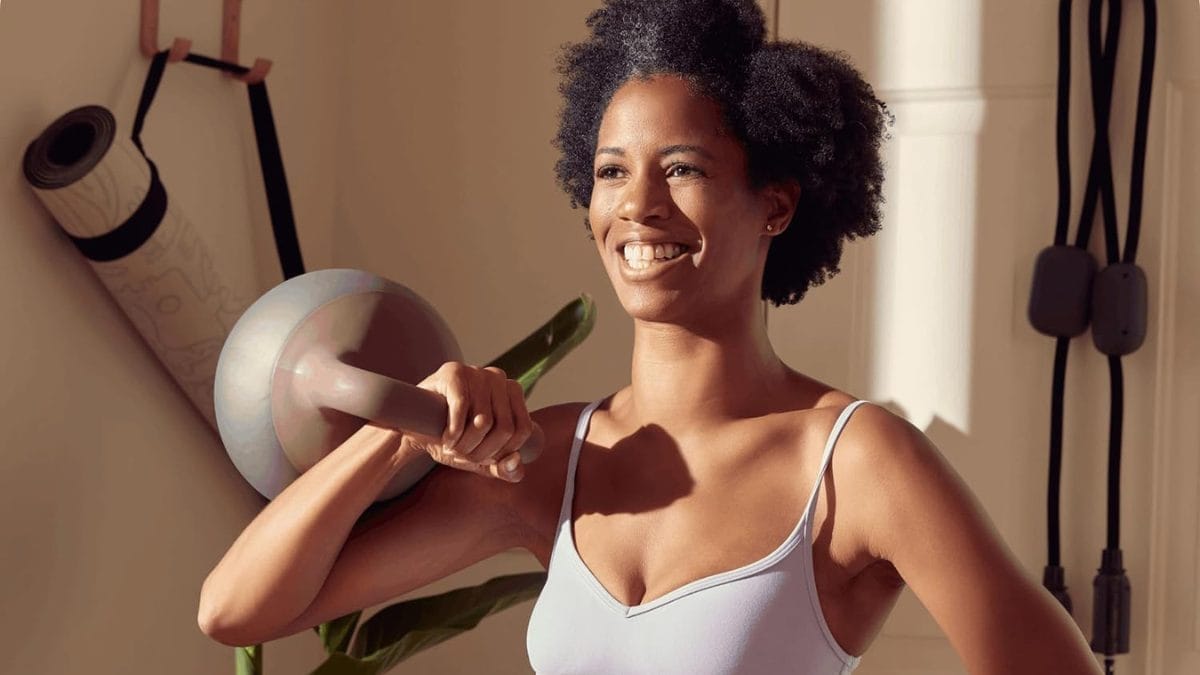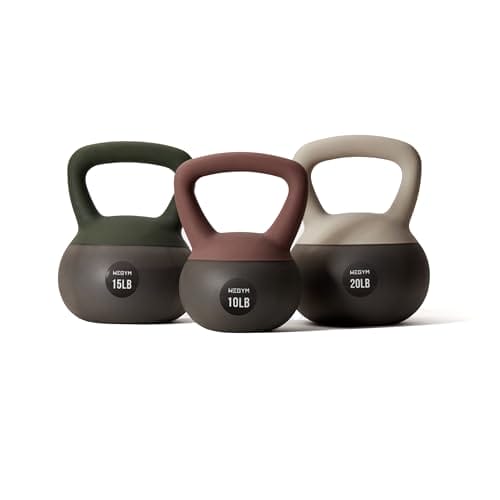Unlock Your Fitness Potential
Dive into the world of KETTLEBELL EXERCISES and discover how they can elevate your workouts to new heights! This guide provides essential steps to effectively integrate them into your fitness routine, helping you achieve your goals and unlock your true fitness potential. Get ready to transform your workouts!
What You Need to Get Started
- A kettlebell (choose an appropriate weight for your fitness level)
- Comfortable workout clothes
- A safe, clutter-free exercise space
- Basic understanding of weight training concepts
- Water bottle for hydration
Choosing the Right Kettlebells for You
Evaluate your fitness level. If you’re a beginner, select a kettlebell that weighs between 8–15 lbs (4–7 kg) for females and 15–25 lbs (7–11 kg) for males. This weight allows you to focus on form without risking injury. For intermediate to advanced users go for 18 lbs (8 kg)and above for women and 35 lbs (16 kg) or more for men.
Consider your goals. If your focus is strength building, opt for a heavier kettlebell. If you aim for endurance or fat loss, a lighter weight with higher repetitions is ideal. For example, an intermediate user focusing on endurance could can find success with a 12 kg kettlebell for high-rep swings.
Factor in your body weight. A common guideline is to choose a kettlebell that is roughly 10-15% of your body weight. If you weigh 70 kg (154 lbs), start with a kettlebell weighing 7 to 10 kg (15 to 22 lbs).
Test before you buy. If possible, try different types and weights of kettlebells at your local gym or store. Comfortable handles and balanced weights enhance your workout experience significantly.

Mastering Basic Kettlebell Movements
Learn essential movements. Master the foundational kettlebell exercises: swings, goblet squats, and deadlifts. These moves form the backbone of a solid kettlebell routine.
Execute the kettlebell swing.
Stand with your feet shoulder-width apart, kettlebell on the floor slightly in front of you. Hinge at your hips, grab the kettlebell with both hands, and drive your hips forward while swinging the kettlebell up to shoulder height. Keep your core engaged and your back straight to prevent injury.
Why? Initiated by a hip thrust from your hamstring and glutes, and using heavy weights (that you have built up to using safely) for up to 90 seconds a set will improve your anaerobic fitness, accelerate your heart-rate and ignite fat-burn.
Perfect the goblet squat.
Hold the kettlebell close to your chest with both hands, elbows pointing down. With your feet shoulder-width apart, squat down by pushing your hips back and bending your knees. Lower yourself until your thighs are parallel to the ground. Maintain a straight back and push through your heels to return to standing.
Why? When it comes to fat-burning, it’s hard to beat the goblet squat. As a royal compound move the kettlebell goblet squat builds massive lower-body strength and powerful glutes. This can be transferred to your deadlifts and your running technique.
Master the deadlift.
Place the kettlebell on the ground between your feet. Stand with your feet shoulder-width apart and hinge at your hips to grab the kettlebell with both hands. Keep your back flat and engage your core as you stand up, pulling the kettlebell upwards, then lower it back down while maintaining control.
With practice, these movements will build your strength and stability, paving the way for more advanced kettlebell exercises.
Why? The deadlift is one of the best exercises when you start your deadlift journey. The deadlift is a compound move, meaning it will fire up multiple muscle groups in minimal time.
Creating Your Kettlebell Workout Routine
Design your routine around your fitness goals. Start by identifying what you want to achieve: strength, endurance, or flexibility.
Balance your workout. Aim for a mix of exercises. For example, use swings and deadlifts for strength, high-rep kettlebell halos for shoulder mobility, and windmills for flexibility.
Structure your sessions. Consider a circuit format. Perform each exercise for 30 seconds with 15 seconds rest in between, repeat the circuit three times. A sample routine could include:
- Kettlebell Swing (30 secs)
- Goblet Squat (30 secs)
- Kettlebell Row (30 secs)
- Rest (1 min)
Vary intensity. To build endurance, increase reps with a lighter kettlebell. For strength, challenge yourself with heavier weights but reduce reps. For instance, if you usually do 15 swings with a 12 kg kettlebell, try 8 swings with a 16 kg kettlebell.
Include rest days. Prioritize recovery. A two-on, one-off approach allows your body to heal and adapt, promoting better performance in subsequent workouts.
With these strategies, you can create a kettlebell routine that not only meets your fitness needs but also keeps your workouts engaging and effective.
Incorporating Kettlebell Exercises Into Your Fitness Journey
Integrate kettlebells into your current routine. Start by identifying what workout styles you already enjoy, whether it’s strength training, cardio, or functional fitness. Kettlebells enhance both cardio and strength training. For example, if you follow a HIIT regimen, substitute a few bodyweight movements with kettlebell exercises like swings or snatches to boost intensity and target more muscle groups.
Modify traditional exercises. Incorporate kettlebells into familiar movements. Replace dumbbells in your upper-body strength routine with the kettles for exercises like shoulder presses or bent-over rows. This shift increases core engagement and stability, as their weight distribution is unique compared to traditional weights.
Create kettlebell circuits. Design circuits that alternate between kettlebell exercises and other forms of training. For instance, perform a set of kettlebell goblet squats followed by a short burst of jumping jacks or burpees. This method keeps your heart rate elevated and maximizes calorie burn.
Use for mobility work. Incorporate kettlebell halos and Turkish get-ups to enhance your range of motion and flexibility. These exercises not only improve mobility but also strengthen stabilizing muscles, paving the way for more advanced workouts.
Experiment with frequency. Use kettlebells two to three times a week, supplementing with your regular training days. This approach fosters adaptation while preventing burnout, ensuring that your fitness journey remains dynamic and diverse.
Tracking Your Progress and Staying Motivated
Monitor your workouts systematically. Keep a log of your kettlebell sessions to track exercises, sets, reps, and weights used. This can be as simple as a notebook or using a fitness app. For instance, note when you increased your kettlebell weight or completed a new personal best in swings.
Set SMART goals. Define Specific, Measurable, Achievable, Relevant, and Time-bound goals to guide your progress. Instead of vaguely stating you want to get stronger, aim to complete 15 swings with a heavier kettlebell in four weeks.
Take photos and measurements. Document your physical changes with progress photos and body measurements. This visual evidence not only motivates you but also helps identify where you’ve improved.
Celebrate milestones. Acknowledge achievements, both big and small. When you hit a goal, treat yourself—maybe a new kettlebell or workout gear. These rewards boost motivation and make the journey enjoyable.
Stay connected. Join online kettlebell communities or local fitness groups for support and inspiration. Sharing your journey with others can keep you engaged and accountable, turning progress tracking into a team effort.
Start Your Kettlebell Journey Today!
With the right kettlebell and knowledge, you’re set to transform your workouts. Embrace the challenge and watch your fitness evolve! Give it a try, share your results, and inspire others. Your kettlebell journey starts now—let’s make progress together!












I love kettlebells! They’ve transformed my workouts completely. The section on tracking progress is a game changer. I started keeping a log and it’s motivating me to push harder every week! 💪
That’s awesome to hear, Chris! Tracking progress is key to staying motivated.
What kind of log do you keep? I’ve been thinking about starting one!
I appreciate the motivation tips at the end! Sometimes it’s hard to stay pumped about working out. I’m going to try to track my progress now!
Awesome! Tracking can really boost motivation!
That’s the spirit! Keep pushing yourself!
Just finished my first kettlebell workout using this guide! I feel like I just ran a marathon, but it was so worth it! Can’t believe how much I sweat. 😂
That’s the kettlebell effect! Keep at it, you’ll get stronger!
Great job, Kevin! Sounds like you gave it your all!
Honestly, I was a bit skeptical about kettlebells at first. I thought they were just a fad. But after trying them out, I can say I’m a big fan now! This guide has given me the confidence to keep going. Thanks! 👍
Welcome to the kettlebell club! It’s definitely not a fad!
So glad to hear that, Ava! Kettlebells can really change your workout game!
This guide is pretty good, but I think it could be more detailed in some areas, especially the workout routines. I need more ideas to keep things fresh!
Thanks for the feedback, Olivia! We’ll look into providing more workout examples.
Yeah, variety is key! Maybe we can crowdsource some routine ideas?
This is a solid guide, but I wish it touched more on advanced techniques. I feel like I’ve mastered the basics and want to push myself further. Maybe a follow-up article? 🤔
Totally agree! I’ve been doing kettlebells for a while now and I’m itching for some new challenges!
Thanks for the feedback, Liam! We’ll definitely consider an advanced techniques follow-up.
I’ve been doing kettlebells for a while, but I’m always curious about how to incorporate them into my existing routine. The tips on blending them in were really helpful!
Happy to hear that, Mia! It’s all about finding the right balance.
Definitely! Mixing it up keeps it interesting!
Kettlebells are awesome, but can we talk about the form? I still struggle with some moves. I appreciate the tips in this guide, but I need more practice!
Practice makes perfect, Ethan! Focus on mastering the basics.
Same! Form is everything with kettlebells!
I love how kettlebells engage so many muscles! I used to only do cardio, but now I feel like I’m actually building strength too. This guide really helped me see their potential! 😍
Right?! They totally mix strength and cardio!
That’s the beauty of kettlebells! Glad you’re seeing the benefits!
Anyone else feel like they have a love-hate relationship with kettlebells? I mean, I love the results, but those swings can be brutal. 😂 Just gotta push through!
Haha, so true! The swings definitely test your limits!
Right?! It’s such a love-hate thing! But the burn is worth it!
I just started using kettlebells and wow, this guide is super helpful! 🙌 I love how it breaks down each section. Choosing the right kettlebell was a game changer for me. I went with the 12kg, thinking I was tough, but I totally underestimated my strength! 😂 Can’t wait to try the workouts listed!
Haha, I did the same thing with my first kettlebell! Went a bit too heavy right away, ended up doing more swinging than lifting! 😂
So glad you found it helpful, Jessica! The right weight is crucial. Start light and build up your strength.
Great guide, but I wish there were more visuals! I’m a visual learner and sometimes it’s hard to picture some of the movements without seeing them. Maybe some videos next time? 🤷♀️
I hear you! Videos would really help clarify those tricky movements!
Great suggestion, Emily! We’ll look into adding visuals or video content for future guides.